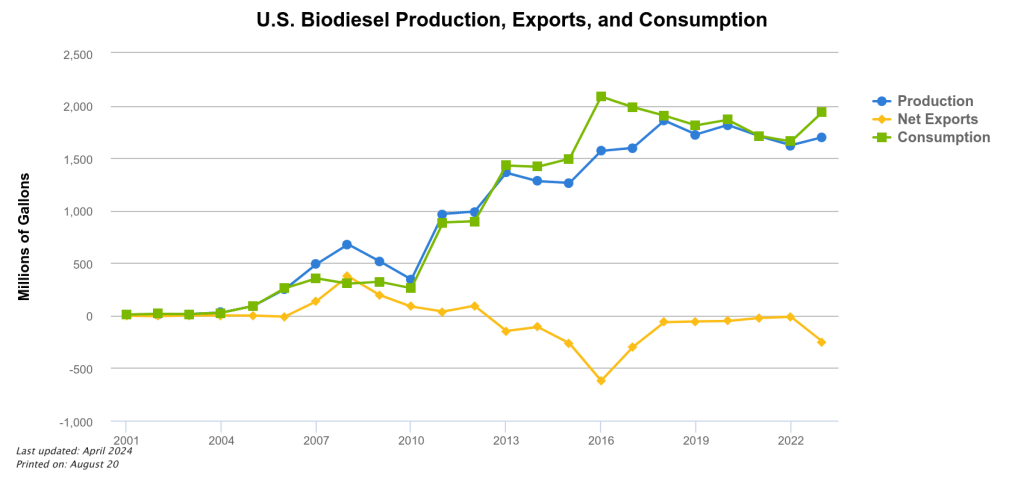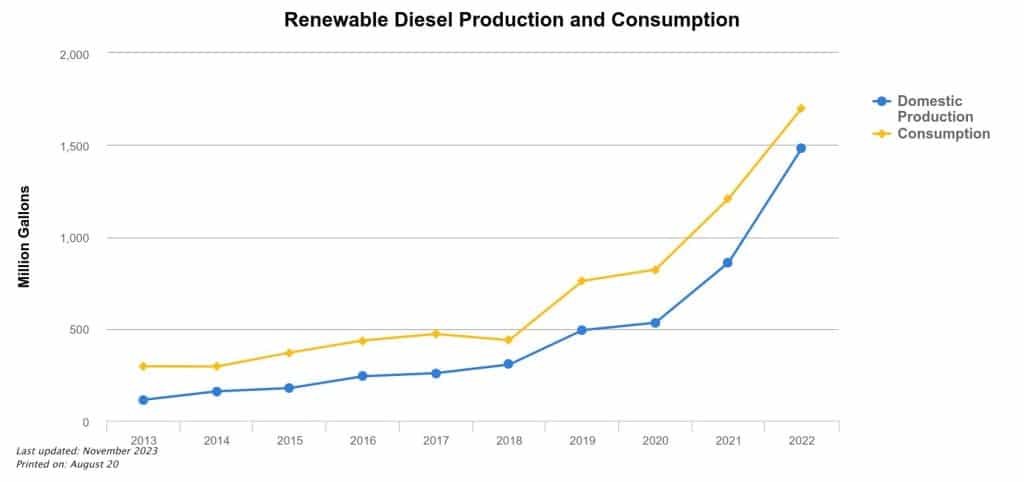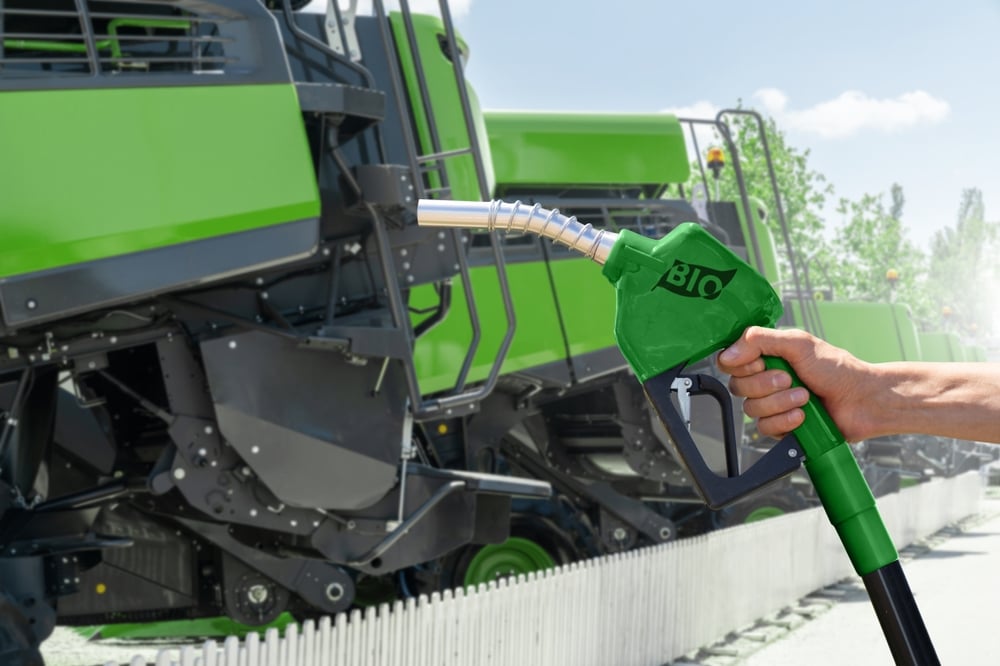In 2024, the biofuel industry is on track for a significant boost. Thanks to increased investments in renewable diesel and biodiesel. The Biden-Harris administration’s support is set to accelerate this growth, making these biofuels key players in the shift toward cleaner energy. Let’s discover what’s happening in this space.
Surge in Renewable Diesel Production
According to the U.S. Energy Information Administration (EIA). the country has seen a major rise in renewable diesel production, with five new plants opening in 2018. This increase pushed the production capacity of this alternative fuel to 282,000 barrels per day (bpd). Recently two new facilities in the Gulf Coast and West Coast regions, and one on the East Coast were installed. With these, the country now has a total 22 renewable diesel plants. Notably, the West Coast alone saw its capacity more than double to 82,000 bpd this year.
But Why Biodiesel Plants Are Struggling?
As U.S. fuel makers shift toward renewable diesel to adapt to the decline of petroleum-based fuels, the production of this biofuel remains expensive and heavily subsidized by federal and state governments. However, the rapid expansion of renewable diesel has squeezed out some biodiesel manufacturers, who receive fewer financial incentives from the government. From media reports, we discovered that over the past year, three biofuel plants—located on the East Coast, West Coast, and Midwest—were forced to close.
Even though biodiesel production capacity is relatively stable at 136,000 bpd, more closures are likely to happen in the future. Talking about closures, Chevron has indefinitely shut down two biodiesel production facilities in the U.S.
Another factor behind the potentially crashing demand for biodiesel is high production costs. It is certainly more expensive than conventional petroleum diesel and renewable diesel. Even though it burns green and generates credits, it is not pocket-friendly. This has led to a slight imbalance in the demand and supply of biodiesel.
Meanwhile, Reuters reported, ethanol production saw a slight boost. Although one plant closed on the East Coast, a newer, larger facility on the Gulf Coast increased the total output capacity of 187 operational plants by 2%, reaching 1.18 million bpd. In another report, the media house also stated that by 2023, the combined output capacity for biomass-based diesel, including biodiesel, in the U.S. exceeded 5 billion gallons.
EIA Uncovers the Shifting Landscape of Biodiesel and Renewable Diesel
EIA reported that biodiesel exports reached their highest point in 2008 due to an “unintended” discrepancy in tax credits in the European Union. However, exports fell sharply after was salvaged. From 2011 onward, biodiesel production and consumption increased, largely driven by the Renewable Fuel Standard. However, in recent years, both production and consumption have declined, possibly due to the rise of renewable diesel.
This chart shows trends in U.S. biodiesel production, exports, and consumption from 2001 to 2023.

Source: EIA
Renewable diesel is becoming more popular because it meets the same quality standards as petroleum diesel. This fuel is mainly produced from used cooking oil and inedible animal fats, which are leftovers from meat processing. It syncs well with diesel engines and infrastructure, requiring no modifications. Renewable diesel is predominantly used in California, where it takes advantage of financial incentives from the Low Carbon Fuel Standard.
This graph shows U.S. renewable diesel fuel production and consumption.

Source: EIA
The Biden-Harris Administration Invests in Domestic Biofuels and Clean Energy
On August 16, the USDA announced that the Biden-Harris administration will invest in domestic biofuels and clean energy as part of President Biden’s Investing in America Agenda. USDA Secretary Tom Vilsack announced $99.6 million in funding through the Higher Blends Infrastructure Incentive Program (HBIIP) and REAP.
It further noted, that ever since the Biden-Harris Administration began, the USDA has invested over $220 million into biofuel access and $2.2 billion into renewable energy projects.
Moving on, they are using the REAP program to support the Justice40 Initiative. It ensures that 40% of the benefits from federal climate and clean energy investments go to communities that have faced underinvestment and pollution. As part of this effort, the USDA is awarding $90.3 million in grants to 89 projects across 26 states.
Can it Revive America’s Future for Biofuels?
This investment, backed by President Biden’s Inflation Reduction Act, aims to increase access to biofuels and clean energy systems. These efforts are designed to strengthen energy independence, create jobs, and provide new opportunities for American farmers and rural communities. Additionally, these grants will help businesses upgrade infrastructure like fuel pumps and storage tanks, boosting economic growth in rural areas.
Secretary Tom Vilsack visited the University of Minnesota and spoke about investing in the American bioeconomy announced, where he disclosed the funding. A significant example of this funding beneficiary is The Corner Store in Inver Grove Heights, which is getting a $518,250 grant to upgrade its fuel infrastructure. The store will install four E15 dispensers, four E85 dispensers, and two ethanol storage tanks. These upgrades are expected to boost ethanol sales by 506,100 gallons per year. Other notable upgrades are:
- In Georgia, CSX Transportation Inc. received a $1.9 million grant to set up a 200-gallon biodiesel storage tank, along with distribution equipment and electric monitoring tools. The company plans to increase biofuel availability by 1 million gallons per year with this investment.
- In Nevada, Anabi Real Estate Development LLC secured a $3.7 million grant to install three E85 dispensers and three B20 dispensers at two fueling stations. This project aims to raise biofuel sales by over 80,000 gallons per year.
Following this, he assured by saying,
“By expanding access to homegrown biofuels and clean energy systems, we are strengthening our energy independence, addressing the impacts of climate change and creating new market opportunities and revenue streams for American producers while bringing good-paying jobs in rural communities.”
Overall, we can count on the right policies and tax incentives for growth of the biofuel. USDA’s new investment plan offers a promising boost for biodiesel, renewable diesel, renewable energy, and other biofuels, paving the way for a smooth transition to clean energy.
- FURTHER READING: Why Shell Hit the Brakes on New Rotterdam’s Biofuel Plant

